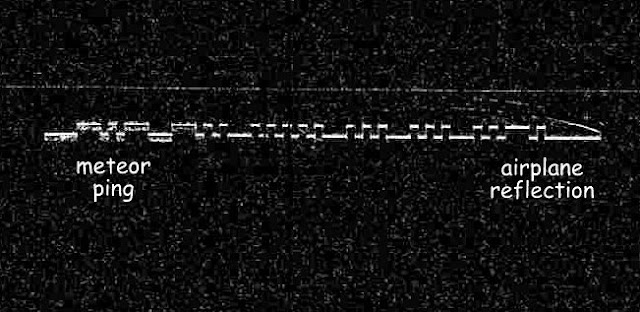This is similar to the previous post about the Geminids Meteor Shower. The difference is that I counted the number of 2 hour periods with a ping In the previous study I noted if there was a ping or pings in a given 10 minute grab and then weighted it by a factor of 2 or 3 depending on how brightness and duration of pings. I then totaled the pings counted is this way for 1 hour periods. I think, or hope, this better represents the time history of the shower.
Experimental Technique
The stability of modern QRSS equipment is such that most signals on the Waterfall Display fall almost exactly on top on each other thanks to the design of the U3S QRSS transmitters available from QRP Labs.
This is considered a Bi-Static Radar. The transmitting station is KD5SSF located in Pensacola, FL running about 200 milliwatts to an inverted V antenna. The receiving station is W4HBK using an inverted V located 10 miles south in Gulf Breeze, FL. I rotated the receiving antenna to minimize KD5SSF's
Figure 1 is a typical grab without evidence of any pings. There are a few artifacts near the trace but they do not have the signature of a ping which is generally a fuzzy, displaced line parallel to the original trace. Figure 2 is a grab taken during the shower to illustrate how I counted pings.
 |
| Figure 1. Grab of KD5SSF without Pings |
 |
| Figure 2. Typical 10 Minute Grab with Pings |
Note the marks at 2 minute intervals. I noted if there was evidence of any ping in each interval and in this case there is for all 4 intervals so I assigned a "4" to this 10 minute period or grab. The absence of signal from 10:40 to 10:42 is a cooling off period to avoid overheating of the U3S's final transistors.
There are problems with interference from other radio signals plus the echoes from aircraft activity at the Pensacola airport located between KD5SSF and myself, Figure 3.
 |
Figure 3. Airplane Interference
|
The actual counting was done by overlaying KD5SSF's signal on the screen of the display with Matte Finish Scotch Tape© and marking the 2 minute intervals. Tape is perfectly clear and does not stick permanently. Nevertheless, don't leave the tape on any longer than necessary as it might mar or damage the display..
Figure 4 is the a table of my counts. The left column is the UTC hour interval and the right column is the counts for each 10 minute interval. For example, look down the hour column to "04-05". In the first 10 minute interval I counted 0 pings then 1, 1, 1, 0 and finally 3 in the 6th for a total of 6.
 |
Figure 4. Table of Counted Pings
|
Results and Discussion
Figure 5 is the histogram of UTC hour vs pings counted for each hour which illustrates the activity over a 24 hour period during this experiment.
 |
| Figure 5. Results |
Based on the hype I read before the shower I was expecting to see a sharp peak around 0300z but as you can see the pings were well below average at that time. Instead, the peak is at about 0900z....what's up?
I should have read the "hype" a little more closely. The Quadrantids is in a very narrow stream and should have produced a very high number of meteors around 0300z for observers in Europe and North Africa. The radiant is near the Bootes constellation which at 0300z would have been just below the horizon at my QTH in Florida so that I would have missed the main peak.
There are two effects going on here. First, the hourly meteor rate is falling off just as the peak comes into view. Secondly, the radiant rises into view for me and like most meteor showers peaks between midnight and dawn when it was at its highest point in the sky around 0900z. Figure 6 illustrates the effect.
 |
| Figure 6. Effect of Radiant View on Meteor Stream |
I don't know why there is a minor peak on the extreme left. There must have been more structure to the stream than just a simple, sharply peaked bell shaped curve.
I reviewed the images and can see no blatant source of error. In fact I probably under-counted pings due to rejecting frames with too many airplane reflections and QRM from the Cyprus radar that lasted from 0520 to 0720z
Conclusions
This is the second recording of pings using the somewhat subtle Doppler shifts occurring on a QRSS signal being observed and recorded using a waterfall display. The fact that both follow the expected rise and fall of pings I believe validates this technique. I see no reason why the ping rates I observe are not at least proportional to the true ping rates. What's amazing to me is that this can be done with a simple transmitter running just 200 mW and modest antenna and receiving equipment.
The only drawback is that the two stations need to be at just the right distance so that the ground wave signal is not so strong as to overpower the receiver and thus reduce the sensitivity to the weaker Doppler signal. It is also possible to rotate antennas and/or use opposing polarizations to obtain a "just right" signal level.
































